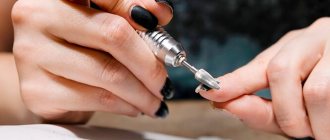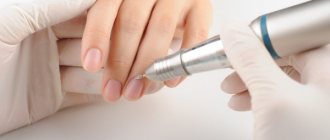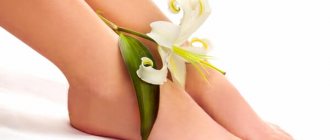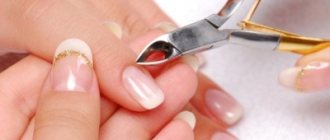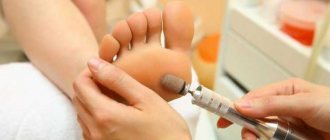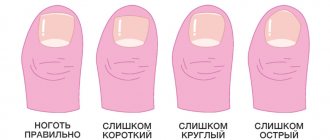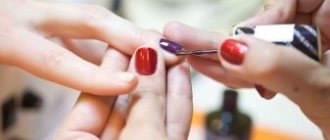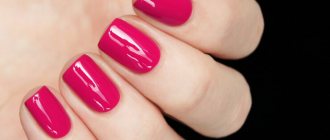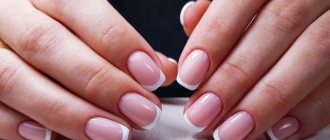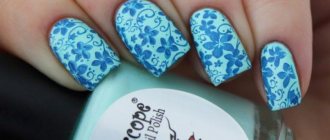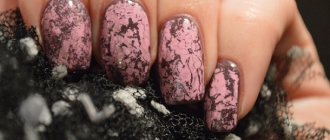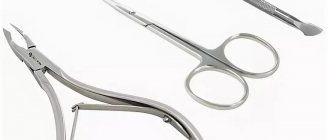Lesson No. 5: How to properly coat clients’ nails with gel polishes
In the client's understanding, a manicure service is hygienic cleaning + coating.
You will be faced with the fact that making an appointment for a manicure will constitute just such a complex, since the thirst for beauty never leaves women and gel polish allows housewives to forget about unpainted nails even with difficult work. We have already successfully learned how to make a salon-quality manicure and pedicure, so this lesson will be devoted exclusively to covering nails with gel polish systems. The online lesson material will teach you:
- Sequences of actions when working with gel polish systems (different brands);
- Proper preparation of the nail plates of the hands and feet, without harm to them;
- Select the necessary tools and tools;
- How to apply the gel so that it lasts for a long time;
- How to apply each component;
- How to quickly assemble flower sets;
- What you need to know so that the client is satisfied with the coating.
To cover your client's nails with gel, you will need:
- coating system (degreaser, base, pigment (gel polish), top);
- liquid for removing the dispersion layer (if necessary, if required by the system);
- ultraviolet lamp with timer for convenience;
- orange stick;
- file 180/240 (if you did not give the free edge a shape at the time of manicure);
- buff for the natural surface of the nail (180/240);
- cotton swabs or pads;
- a thin manicure brush for painting (made of synthetic fibers, they interact perfectly with the gel, unlike natural ones) and decorating materials;
- cuticle oil;
- hand cream.
Types of nail plates - and their corresponding gel structure:
Nails are different in structure, as is the density of the gels, so each plate has its own. To ensure that the coating you make is worn for a long time and not damaged, match the gel and the plate, then the result of the wear will also be ideal. If you talk to your client, she will tell you that different professionals she used, using different brands, gave different results. It is a mistake to think that the same gel suits everyone. It's all about the density of the nail.
The normal type of nail plate is neither thin nor thick, rarely flakes, quickly recovers and grows, it is a pleasure to work with this type. It has a light, uniform, but not transparent pinkish tint, which means that there is a sufficient amount of vitamins in the body, and the diet contains mainly health benefits. It does not require any special nuances; standard approaches are ideal for it. It will wear well on gels of all densities, including glitters.
The thin type of nail plate is brittle and bends when touched with any force. It has a translucent, uneven color with a pink or beige tint. Most likely, this condition is due to vitamin deficiencies and weakened immunity. You should not use too hard gels for this type of nail; it is better to use medium-dense or soft ones. Since nails bend, they are easier to separate from the coating from the slightest touch (for example, when washing dishes, if you help remove leftovers from the plates with your nail), as a result the nail will be broken and the coating will be chipped. But if you take a gel that slightly follows the movements of the nail, then its wearability will be 2 times better.
Dense nail plate - strong, usually grow quickly, bend with difficulty. They have a pink color along the plate and a slight yellowness along the free edge. Sometimes such compaction is caused by hormonal imbalances, but this is not a fact; perhaps this is a normal condition of the nail. All thick and medium-density gels are suitable for such nails, but soft ones that replicate flexibility - no, they do not last long in interaction with this plate.
Hardware manicure technique
This type of nail work can be done both in a beauty salon and at home. Of course, if the procedure is being performed for the first time, it is better to contact an experienced specialist. Subsequently, you can do a hardware manicure yourself, following the following sequence of actions:
- Step 1 Remove (if necessary) the coating from the nails. Nail polish remover should not contain acetone.
- Step 2 Apply a special softening agent to the cuticle and move it with a wooden stick to the side ridges located around the nail. As a rule, such a stick is included in the basic set of a manicure machine.
- Step 3 We begin to process the nails, holding the device in our hand like a fountain pen.
- Step 4 Do not press the attachments too hard against the nail plate, since the manicure apparatus can injure the nail and periungual space.
- Step 5 We remove dry areas of skin using nozzles with medium abrasiveness and treat the side rollers of the fingers.
- Step 6 File the cuticle using a small ball attachment.
- Step 7 Use low-abrasion attachments to smooth (if necessary) dry calluses on the palms.
- Step 8 Sand and polish the nails. Do not touch the tip of the nozzle to the nail plates, as this can lead to unsightly scratches. The hard washcloth included in the hardware manicure kit is usually used for polishing nails.
- Step 9 After completing the procedure, apply oil or cream to your hands and do a light massage.
Step-by-step instruction
If you have already acquired a device and cutters, we recommend that you study the tips on how to properly do a hardware unedged manicure at home:
- The procedure is carried out only on a dry plate. Otherwise, the plate will begin to heat up, which will cause some discomfort. In addition, the areas will be less well processed;
- If you are using a combined or customizable device (for example, Strong), then you need to set the speed to a speed of up to 10,000. If it is higher, then you will simply erase your nails due to the lack of proper experience;
- Do not press the clipper close to your nail or, especially, put pressure on it while working;
- The first few times you need to practice on the silicone tips first. Then, when working with rough cutters, you will already know how to hold them correctly, at what angle and for how long.
Instructions and technology for performing hardware manicure step by step:
- The cuticle needs to be moved closer to the nail hole using a special wooden stick. Try to act carefully so as not to damage it;
- On it and the side rollers on the sides of the plate, the use of drums with medium hardness is allowed. Watch your own feelings, if it seems that the cutters are not removing enough, then you can take tools with more abrasiveness;
- On the palms and fingers, you need to clean dead cells using soft abrasive ball-shaped burs;
Use cylindrical or trapezoidal cutters to give the plate the desired shape. Be careful - the rules of proper manicure require leaving more than 2 mm above the level of the fingertips, even on short nails;
After this, polishing begins. The technique of this stage is quite difficult for beginners. Firstly, you cannot bring the edge of the polisher to the nail - it will scratch the plate, secondly, you cannot hold the polish in one place for longer than 1 second;
- All that remains is to clean the space from dust and nail residues, lubricate it with oil and paint it.
For a better understanding, we recommend watching a video master class from professionals on how to do a hardware manicure.
Video training for beginners on how to do a hardware manicure
How a novice manicurist can learn to apply gel polish perfectly for working in a salon
Selecting a coating gel system:
First of all, decide on the company of the material you want to use. Of course I will note that it would be great if you had several types. But at first, when you are just learning and perhaps still have a limited budget for purchasing, opt for a medium-dense composition.
I will definitely do a broad review of gel polishes, but a little later. Now I will share my experience of choice when I was just starting to work.
UV varnishes are divided into types (number of layers):
- 3 phases (Base, Gel Polish, Top);
- 2 phases (Gel Polish, Top);
- 1 phasers (Gel Polish).
I formed my first palette like this (I always choose 3-phase):
- The first brand I purchased was Creator. Made in the USA. In terms of density, it is the golden mean, that is, almost universal. Each layer is baked for 2 minutes. Its price is quite economical. Since I didn’t have a lot of input, and besides, I was just studying, I decided that it suited all parameters as a training session. My first palette consisted of 10 colors. And I didn’t regret my choice. Combines with other brands, in case its base or top runs out at the wrong time for Gelish and vice versa.
- The next brand is Fox. I added 15 more colors to my palette with neem. Manufacturer USA. This brand is suitable for thin nails, which is exactly what I was missing. By the way, on a normal type of plate it is also good to wear. Each layer is baked for 2 minutes. Doesn't fit well with other brands, wear depends on degreaser, wears better with those that leave stickiness rather than just evaporate. Its cost is higher than the creator's, but not significantly, it belongs to the premium class. Doesn't give the nail any special density, but lasts a long time.
- To these I added a few shades of Blaze GelLaxy. I bought only 5 colors. It is very dense and thick, for compacted and normal nails. Each layer is baked for 2-2.5 minutes. It is also produced in the USA, it is one of the premium ones that appeared first, I could not help but buy it. Coating with Gelish system is possible.
- The completion of my varied tablet was Gelish polishes. Belongs to the premium class. Made in USA. Universal, medium density allows you to cover any plate with it. The price is higher than average, but corresponds to its quality. Each layer is baked for 2 minutes.
- As universal bases, I chose a base from Kodi (which usually requires 2 minutes for baking) and a primer with a sticky layer from Blaze. Excellent to wear and apply, guarantee perfect adhesion, I used them at the same time.
- To remove the gel and dispersion layer I used Jerden Proff Gel Cleanser. They work perfectly and are inexpensive.
My strategy was simple: I needed to stay within the budget, start doing as many services as possible in order to earn money, develop and gain experience. Therefore, I chose a good quality gel polish, bought system products for it (bond, top, base) in several basic colors. I started studying and working. At the same time, I also bought materials for extensions, but I didn’t skimp here, I chose expensive ones that matched the price with quality. This is how I realized my goals. As soon as the work of a manicurist began to generate income, I replenished my supplies with new products + systems for them. All this isn't cheap, so buy some foundations and a couple of shades, adding to them over time. So I created for myself a varied palette suitable for everyone, which was full of colors.
How to present the palette of your gels to your clients? - to do this, make a tablet; you should not constantly unwind the gels, this spoils them.
Tip: It will be economically beneficial for you if you distribute your palette by cost. For the client, this is another point of concern, so you will show care to each client, both to those who can afford expensive brands and to people with modest means. Feel free to explain the price difference, but do it correctly. For example, say that the varnish, the coating of which is the cheapest and is not inferior in quality, is almost the same as the expensive one, but the purchase price is slightly lower, although there is still a difference in the coating - this is shine and brightness. This approach works, clients will be satisfied, and your capabilities in diversity as a master will once again impress them.
How I choose gel polish, my methods:
- The first thing I pay attention to is the smell. A quality product smells pleasant or neutral, but if the smell is too poisonous and reminiscent of plastic, you most likely will not be satisfied.
- I look at the composition. The question here is not density, but consistency, it should be uniform (if it is one tone or pearlescent, the sparkles may settle - this is normal), further, there should be no lumps, it should be optical, so pay attention to how the gel flows by brush. IMPORTANT: remember, gels tend to stagnate, they also have an expiration date, so be careful and do not buy stale ones. Try to make purchases in well-known professional cosmetics stores, there are a large number of visitors there, so they do not have time to stagnate.
- Consider the tablets, how this composition lay down as an example. Usually in stores they are covered by the consultants themselves.
- Personally, I like American-made gels best.
- Try to buy base, top, bond (primer) separately for each gel. But I had universal ones.
Pros of gel polish coating:
- quick drying using a UV lamp,
- strengthening nails (nails actually grow faster and become stronger),
- durability of the coating (within 2-3 weeks your nails will look perfect),
- versatility (can be used on nails of any length),
- affordable price,
- beautiful rich shades,
- ease of application.
Learn how to professionally apply gel polish on fingernails and toenails
Classic technique, suitable for all brands - step-by-step instructions:
- Let's start with confidence, throw away the thoughts that you can't handle it. Hands should not shake. Wear gloves and a mask. Prepare bottles with coatings, a hand rest and a lamp.
- Before the gel comes into contact with the nail plate, it needs to be prepared; to do this, take a soft buff (180/240 grit) and carefully remove the top shiny layer of the nail. Direct the buff from the cuticle to the free edge, that is, in the direction of growth. IMPORTANT! - do not even think about using a nail file in this process, even a soft one, if you want the client’s nails to remain healthy and the coating not to cause any damage. The fact is that the buff will gently remove the shine, which is enough for the coupling, but the file will damage the integrity of the plate, leaving grooves. It’s difficult to notice them with a glance, but the nails will definitely peel.
- Check the plate again, it should be completely clean. Apply a small amount of primer to each nail and let it dry for a minute. IMPORTANT: gel peeling often occurs if the gel is applied to nails that are wet from the primer; allow it to evaporate slightly, along with the oil. It looks like this, after baking the base will have gaps, which will later allow fat to pass through and the varnish will peel off.
- Take the base for the gel polish; its layer should be thin, evenly distributed over the entire surface of the nail. Bake for two minutes.
- The next stage is pigment. Spread it like the base, the first layer very thinly, but try to avoid gaps, this is the basis of an even, beautiful coating. The first time, if you are not sure, do not paint all your fingers at once. Try 2 fingers at a time until you understand how the gel polish behaves. IMPORTANT: Do not bake all 5 fingers of one hand in the lamp, the gel from the first finger may leak. Place the UV oven on the edge so that clients feel comfortable and ask them to send four fingers of one hand and the first finger of the opposite hand.
- After dirtying the cuticle, use an orange stick; do not touch the client with your nails - this is not aesthetically pleasing.
- Apply a second layer of pigment, but not as thin as the first time. Bake for 2 minutes.
- The last stage is Thor, cover the previous layers with a thin layer and bake for 2 minutes.
- Remove the sticky layer with a special liquid and a microfiber cloth. IMPORTANT: do not use alcohol or disinfectant; the fixative will lose its shine.
- Moisturize the cuticle with oil and the skin of your hands with cream.
Two people will be happy with the result - you and the client, who will definitely come back again. The main thing is not to neglect the rules, train more. You will soon learn to feel each material and understand how to work with it at first sight.
Nuances:
- If you did a manicure before coating, then it should end with the removal of the cuticle, without moisturizing with oil and cream. Immediately after hygiene procedures, feel free to start applying the gel.
- If the client came to just cover her nails without a manicure, remove the old polish and let them rest for a couple of minutes. Correct the shape of the free edge of the nail and apply the gel according to the instructions.
- If the client wants a design, then place it between the pigment-Tor layer.
- It can be applied to extended nails without a base, if there is no regrown part of the natural nail, otherwise there should be a base.
In the next lesson, I will teach you novice nail artists how to create incredible designs for your clients and attach jewelry to their nails.
Go to lesson #6
